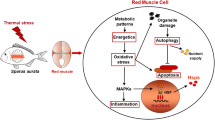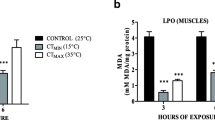Abstract
Amazon fish are vulnerable to climate change. Current temperature increases in Amazonian rivers are likely to continue in the coming years. Elevated temperatures impair homeostasis and subject fish to oxidative stress; nevertheless, the effects of elevated temperature on plasma and muscle oxidative stress as well as fillet fatty acid composition in matrinxã (Brycon amazonicus) remain unknown. Therefore, the aims of the present study were to determine whether antioxidant system is able to withstand acute thermal stress to avoid plasma and muscle oxidative damage and to determine the manner in which matrinxã adjust their muscle fatty acid metabolism in a response to acute heat stress. We exposed juvenile matrinxã to four temperatures (28 °C as control and 30, 32, and 34 °C) for 72 h and observed the effects on plasma and muscle oxidant/antioxidant status and on fatty acid composition. Plasma reactive oxygen species (ROS) and lipid peroxidation (LPO) levels were significantly higher in matrinxã exposed to 34 °C compared with the control group, while they were significantly higher in the muscle of matrinxã exposed to 32 °C and 34 °C compared with the control group. Superoxide dismutase (SOD) activity and total antioxidant capacity (TAC) levels were significantly lower in the plasma and muscle of matrinxã exposed to 34 °C compared with the control group. Plasma glutathione peroxidase (GPx) activity was significantly lower in matrinxã exposed to 32 and 34 °C compared with the control group, while it was significantly lower in the muscle of matrinxã exposed to 34 °C. The total content of saturated fatty acid (SFA) was significantly higher in the fillet of matrinxã exposed to 34 °C compared with the control group, while the total content of polyunsaturated fatty acid (PUFA) was significantly lower. Based on this evidence, we conclude that acute heat stress at 32 °C and 34 °C causes plasma and muscular oxidative stress, and the enzymatic and non-enzymatic antioxidant system is unable to prevent oxidative damage. Moreover, increased levels of total SFA and decreased levels of PUFA occur in an attempt to withstand heat stress and maintain membrane fluidity; nevertheless, these responses can represent negative impacts for consumers.


Similar content being viewed by others
References
Amado LL, Garcia ML, Ramos PB, Freitas RF, Zafalon B, Ferreira JLR, Yunes JS, Montserrat JM (2009) A method to measure total antioxidant capacity against peroxyl radicals in aquatic organisms: application to evaluate microcystins toxicity. Sci Total Environ 407:2115–2123
Ashaf-Ud-Doulah M, Shahjahan M, Islam SMM, Al-Emran M, Rahman MS, Hossain MAR (2019) Thermal stress causes nuclear and cellular abnormalities of peripheral erythrocytes in Indian major carp, rohu Labeo rohita. J Therm Biol 86:102450
Baldissera MD, Souza CF, Val AL, Baldisserotto B (2020) Involvement of purinergic signaling in the Amazon fish Pterygoplichthys pardalis subjected to handling stress: relationship with immune response. Aquaculture 514:734481
Bligh EG, Dyer WJ (1959) A rapid method of total lipid extraction and purification. Can J Biochem Physiol 37:911–917
Cai LS, Wang L, Song K, Lu KL, Zhang CX, Rahimnejad S (2020) Evaluation of protein requirement of spotted seabass (Lateolabrax maculatus) under two temperatures, and the liver transcriptome response to thermal stress. Aquaculture 516:734615
Campos DF, Braz-Mota S, Val AL, Almeida-Val VMF (2019) Predicting thermal sensitivity of three Amazon fishes exposed to climate change scenarios. Ecol Indic 101:533–540
Cardoso PG, Resende-de-Oliveira R, Rocha E (2019) Combined effects of increased temperature and levonorgestrel exposure on zebrafish female liver, using stereology and immunohistochemistry against catalase, CYP1A, HSP90 and vitellogenin. Environ Pollut 252:1059–1067
Cheng HL, Xia DQ, Wu TT (2006) Fatty liver and regulation of lipids metabolism in fish. Chin J Anim Nutr 18:294–298
Corrêa CF, Nobrega RO, Block JM, Fracalossi DM (2018) Mixes of plant oils as fish oil substitutes for Nile tilapia at optimal and cold suboptimal temperature. Aquaculture 497:82–90
De Almeida CAL, De Almeida CKL, Martins EFF, Gomes AM, Pimentel LA, Pereira RT, Fortes-Silva R (2019) Effect of the dietary linoleic/α-linolenic ratio (n-6/n-3) on histopathological alterations caused by suboptimal temperature in tilapia (Oreochromis niloticus). J Therm Biol 85:102386
De Barros IBA, Villacorta-Correa MA, Carvalho TB (2019) Stocking density and water temperature as modulators of aggressiveness, survival and zootechnical performance in matrinxã larvae, Brycon amazonicus. Aquaculture 502:378–383
De Souza MRDP, Herrerias T, Zaleski T, Forgati M, Kandalski PK, Machado D, Silva TS, Piechnika CA, Moura MO, Donattia L (2018) Heat stress in the heart and muscle of the Antarctic fishes Notothenia rossii and Notothenia coriiceps: Carbohydrate metabolism and antioxidant defence. Biochimie 146:43–55
Erel O (2004) A novel automated method to measure total antioxidant response against potent free radical reactions. Clin Biochem 37:112–119
Fadhaoui M, Couture P (2016) Combined effects of temperature and metal exposure on the fatty acid composition of cell membranes, antioxidant enzyme activities and lipid peroxidation in yellow perch (Perca flavescens). Aquat Toxicol 180:45–55
FAO (2018) The state of world fisheries and aquaculture: meeting the sustainable development goals. In: Food and Agriculture Organization of the United Nations. Rome.
Gaschler MM, Stockwell BR (2017) Lipid peroxidation in cell death. Biochem Biophys Res Commun 482:419–425
Hartman L, Lago RC (1973) Rapid preparation of fatty acid methyl esters from lipids. Lab Pract 22:475–477
Hazel JR (1995) Thermal adaptation in biological-membranes—is homeoviscous adaptation the explanation. Annu Rev Physiol 57:19–42
Hsieh SL, Liao WL, Kuo CM (2001) Molecular cloning and sequence analysis of stearoyl-CoA desaturase in milkfish, Chanos chanos. Comp Biochem Physiol 130B:467–477
IPCC (2013) Fifth Assessment Report on Climate Change 2013: The physical science basis, final draft underlying scientific-technical assessment. Intergovernmental Panel on Climate Change. Working Group 1, Geneva.
Islam MA, Helal Uddin M, Uddin MJ, Shahjahan M (2019) Temperature changes influenced the growth performance and physiological functions of Thai pangas Pangasianodon hypophthalmus. Aquaculture Rep 13:100179
Kumar N, Gupta SK, Bhushan S, Singh NP (2019) Impacts of acute toxicity of arsenic (III) alone and with high temperature on stress biomarkers, immunological status and cellular metabolism in fish. Aquat Toxicol 214:105233
LeBel CP, Ischiropoulos H, Bondy SC (1992) Evaluation of the probe 2',7'-dichlorofluorescin as an indicator of reactive oxygen species formation and oxidative stress. Chem Res Toxicol 5:227–231
Ma XY, Qiang J, He J, Gabriel NN, Xu P (2015) Changes in the physiological parameters, fatty acid GIFT tilapia (Oreochromis niloticus) reared at three different temperatures. Fish Physiol Biochem 41:937–950
Macedo MN, Coe MT, DeFries R, Uriarte M, Brando PM, Neill C, Walker WS (2013) Land-use-driven stream warming in southeastern Amazonia. Philos Trans R Soc Lond Ser B Biol Sci 368:20120153
Marengo JA (2009) Future change of climate in South America in the late 21st century: the CREAS project. Atmos Sci Sect AGU Newsl 3(2):5.
Marklund S, Marklund G (1974) Involvement of the superoxide anion radical in the autoxidation of pyrogallol and a convenient assay for superoxide dismutase. Eur J Biochem 47:469–474
Michielsen CCJR, Hangelbroek RWJ, Feskens EJM, Afman LA (2019) Disentangling the effects of monounsaturated fatty acids from other components of a mediterranean diet on serum metabolite profiles: a randomized fully controlled dietary intervention in healthy subjects at risk of the metabolic syndrome. Mol Nutr Food Res 63:e1801095
Mohanty BP, Mahanty A, Ganguly S, Mitra T, Karunakaran D, Anandan R (2019) Nutritional composition of food fishes and their importance in providing food and nutritional security. Food Chem 293:561–570
Monserrat JM, Geracitano LA, Pinho GLL, Vinagre TM, Faleiros M, Alciati JC, Bianchini A (2003) Determination of lipid peroxides in invertebrates using the Fe (III) xylenol orange complex formation. Arch Environ Contam Toxicol 45:177–183
Osmond ATY, Colombo SM (2019) The future of genetic engineering to provide essential dietary nutrients and improve growth performance in aquaculture: Advantages and challenges. J World Aquacult Soc 50:490–509
Paglia DE, Valentine WN (1967) Studies on the quantitative and qualitative characterization of erythrocytes glutathione peroxidase. J Lab Clin Med 70:158–169
Pernet F, Tremblay R, Comeau L, Guderley H (2007) Temperature adaptation in two bivalve species from different thermal habitats: energetics and remodelling of membrane lipids. J Exp Biol 210:2999–3014
Portner HO (2002) Climate variations and the physiological basis of temperature dependent biogeography: systemic to molecular hierarchy of thermal tolerance in animals. Comp Biochem Physiol A Mol Integr Physiol 132:739–761
Sukhovskaya IV, Borvinskaya EV, Smirnov LP, Kochneva AA (2017) Role of glutathione in functioning of the system of antioxidant protection on fish (Review). Ecol Physiol Biochem Hydrob 10:97–102
Van Dijk SJ, Feskens EJM, Bos MB, Hoelen DWM, Heijligenberg R, Bromhaar MG, de Groot LCPGM, de Vries JHM, Muller M, Afman LA (2009) A saturated fatty acid–rich diet induces an obesity-linked proinflammatory gene expression profile in adipose tissue of subjects at risk of metabolic syndrome. Am J Clin Nutr 90:1656–1664
Viña J, Borras C, Gomez-Cabrera MC (2018) A free radical theory of frailty. Free Radic Biol Med 124:358–363
Visentainer JV (2012) Aspectos analíticos da resposta do detector de ionização em chama para ésteres de ácidos graxos em biodiesel e alimentos. Quim Nova 19:380–385
Wang Y, Han G, Pham CV, Koyanagi K, Song Y, Sudo R, Lauwereyns J, Cockrem JF, Furuse M, Chowdhury VS (2019a) An acute increase in water temperature can increase free amino acid concentrations in the blood, brain, liver, and muscle in goldfish (Carassius auratus). Fish Physiol Biochem 45:1343–1354
Wang Y, Li C, Pan C, Liu E, Zhao X, Ling Q (2019b) Alterations to transcriptomic profile, histopathology, and oxidative stress in liver of pikeperch (Sander lucioperca) under heat stress. Fish Shellfish Immunol 95:659–669
Zaniboni-Filho E, Reynalte-Tataje D, Weingartner M (2006) Potencialidad del género Brycon en la piscicultura brasileña. Rev Colom Ciênc Pecua 19:233–240
Acknowledgments
The authors are grateful to the Conselho Nacional de Desenvolvimento Tecnológico (CNPq), Comissão de Aperfeiçoamento de Pessoal de Nível Superior (CAPES, finance code 001), and INCT-ADAPTA ((CNPq, 465540/2014-7)/FAPEAM 062.1187/2017/CAPES, finance code 001).
Author information
Authors and Affiliations
Corresponding author
Ethics declarations
Ethical approval
The Ethics Committee of INPA authorized all experimental procedures under the number 004/2018, SEI 01280.000209/2018-74.
Additional information
Publisher’s note
Springer Nature remains neutral with regard to jurisdictional claims in published maps and institutional affiliations.
Rights and permissions
About this article
Cite this article
Baldissera, M.D., Souza, C.F., Barroso, D.C. et al. Disturbance of oxidant/antioxidant status and impairment on fillet fatty acid profiles in Brycon amazonicus subjected to acute heat stress. Fish Physiol Biochem 46, 1857–1866 (2020). https://doi.org/10.1007/s10695-020-00835-3
Received:
Accepted:
Published:
Issue Date:
DOI: https://doi.org/10.1007/s10695-020-00835-3




